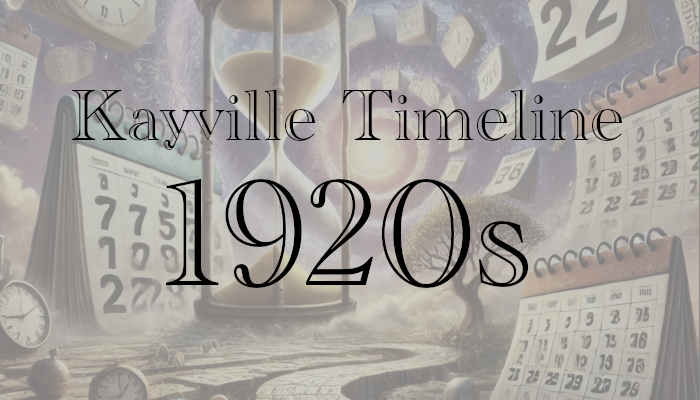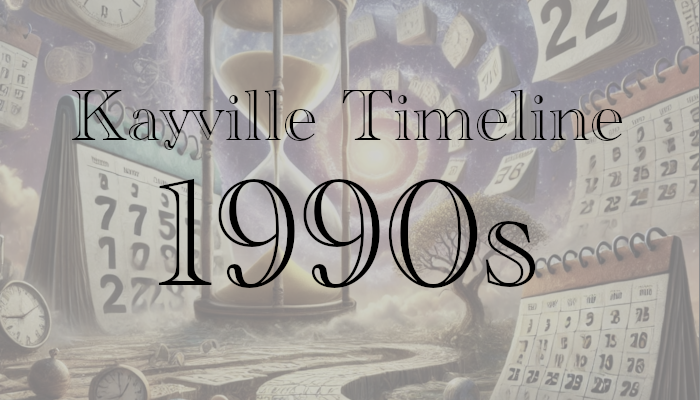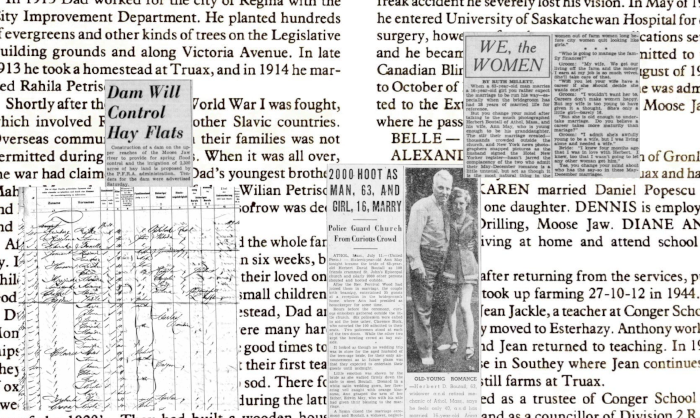The 1920s were a decade of growth and optimism for Saskatchewan, tempered by emerging economic vulnerabilities and ongoing social issues. This period set the stage for the significant challenges and transformations of the 1930s.
The decade started with an economic boom for Saskatchewan, largely driven by agriculture. The province was one of Canada’s leading grain producers, and high global demand for wheat contributed to prosperity. This led to increased settlement, with many new immigrants arriving, drawn by the promise of fertile land and economic opportunity. Agriculture’s success spurred related industries, including construction and services, boosting urban growth in cities like Saskatoon and Regina.
With the economic boom, there was significant investment in infrastructure. Rail networks expanded extensively during this period, facilitating easier movement of goods and people. This expansion supported agricultural export capabilities and helped integrate rural areas more closely with urban centers. Additionally, public services expanded, including schools and hospitals, to accommodate the growing population.
The 1920s also saw notable social changes in Saskatchewan. The province experienced a degree of cultural flourishing as communities grew and diversified. However, the decade was not without its challenges. The prosperity of the early 1920s began to wane towards the end of the decade as wheat prices started to fall, leading to economic strain that foreshadowed the hardships of the 1930s.
Politically, the 1920s in Saskatchewan were characterized by the dominance of progressive ideas, which later influenced the rise of cooperative movements and the foundation of the Co-operative Commonwealth Federation (CCF) in the 1930s. The seeds of social welfare and economic reform policies were sown during this period, reflecting a growing awareness of the need for a more equitable distribution of wealth and resources.
For Indigenous communities, the 1920s were a period of continued hardship. Federal policies of assimilation and the residential school system profoundly impacted Indigenous cultures and societies in Saskatchewan. Despite these challenges, the decade also saw the beginnings of organized resistance and advocacy for Indigenous rights, which would gain momentum in later decades.
Timeline (1920 – 1929)
1920
- Eftim Ritco in partnership with Avram Kozack and Bill Kozack built a poolroom on the Ritco homestead beside Dan T. Kozak’s ‘The Store on the Hill’ two miles northwest of Kayville.1
- (abt 1920) A group of Kayville citizens posed for a photo which I talk about in Kayville Citizens 1920
1921
- Dan T. Kozak becomes the Postmaster for Kayville Post Office on April 1, 1921 in The Store on the Hill. He would perform this service until resigning November 10, 1926.2,3,4
- June 1921 Saskatchewan residents were enumerated for the Canada Census.5
- 1921 Holy Trinity Russian Orthodox Church 2 miles west of Kayville built.1,6
- bef 1922 A.D. Donison operated a flour mill a half-mile outside of Kayville, on or near SW-13-09-24-W2 north of the tracks.1
1922
- 1922 Charlie Chaplin movie shown on the inside wall of A.D. Donisan’s flour mill.1
- 1922 George Ursu Sr. ran a livery barn and dray business in the early days for the town. George Ursu Sr. operated his dray business for about twenty-two years before a succession of entrepreneurs took over beginning around 1944 or 1945.1,7
- 1922 Diphtheria epidemic claims some lives during the summer.8
- 1922 While radio was first introduced in Canada around 1922 its popularity only grew from this point. Radios in Kayville would have been powered by batteries as electricity did not reach the town until 1953.1,9
1923
- 1923 Holy Trinity Russian Orthodox Parish Cemetery created beside the church on land donated by Clim Ritsco.10
- 1923 Saskatchewan’s first radio stations go on the air. CKCK Radio in Regina and CFQC in Saskatoon gave people their first opportunity to hear news and ideas from over the horizon and around the world faster than the newspapers they knew could.11
- 1923 Fire!! During a blizzard and in the middle of the night on February 14, a fire in nearby Truax destroyed most of the town’s main street. Residents fought the blaze during the blizzard by shovelling snow into the flames. Damaged in the fire were the Municipal Office, Bank of Hamilton, J.L. Killorin General Store and Thomas Newman Livery Stable.12

1924
- 1924 Canadian Pacific Railroad (CPR) completes Amulet-Cardross railroad line to Kayville in the autumn. It would operate for seventy-four years until 1998.1,13
- 1924 Dan T. Kozak closes ‘The Store on the Hill’ two miles NW of town and builds a new store in Kayville. The store would operate for twenty-one years until selling it in 1945.1,14
- 1924 Saskatchewan government repeals prohibition which was enacted eight year earlier in 1916.15
- 1924 Eftim Ritco moves the poolroom he operated beside the Kozak ‘Store on the Hill’ into town where it is expanded and a bowling alley is added. The building is moved in the winter and pulled to Kayville atop sleds by horses. Sixteen years later in 1940 it would be renovated to become the Kayville Community Hall.1,16,17
- 1924 Dan Ritsco builds a new store on the northeast corner of the main intersection on the south side of Eftim Ritco’s poolroom1
- 1924 Alex Bodnaresk builds a two storey business with a cafe on the ground floor and hotel rooms on the second floor. This was Kayville’s first Cafe. Alex Bodnaresk later sold the Cafe to Charlie Quong and Bill Fong who then in turn sold eventually to Tom Chow.1 See also Kayville Hotel and Cafe 1924
- 1924 First I.H.C. Dealership opened by Howard Argue1
- 1924 Saskatchewan Co-operative Elevator Company begins construction of the first grain elevator1
1925
- abt 1924-1926 Hope Lutheran Church built in Kayville1
- abt 1925 Star Company begins construction of Kayville’s second grain elevator1
- 1925 Pete Allen opened a hardware store1
- 1925 Butcher shop operated by George Wagner on the southwest corner of the main intersection1
- 1925 Chevrolet Dealership and Mechanic’s garage opened by Joe Surdu on southeast corner of main intersection1

- aft 1925 George Popescu operated a store on the northwest corner of the main intersection until 19441,18
- aft 1925 George Popescu took over the I.H.C. Dealership from Howard Argue1
- aft 1925 George Popescu took over as Agent of the Imperial Oil agency 1
1926
- 1926 Saskatchewan Wheat Pool purchases what was Kayville’s first grain elevator from the Saskatchewan Co-operative Elevator Company1
- 1926 Saskatchewan residents were enumerated for the Census of Prairie Provinces in June 1926
- 1926 John P. Popescu, Todor Guraluick and Elie Krasiun partnered to run a bowling alley and poolroom on the southwest corner of the main intersection. The venture was closed by about 1930.1
- 1926 Dan T. Kozak resigns as Postmaster for Kayville Post Office November 10, 1926 after five years.19
1927
- abt 1927 Karl Jackle Sr. operated a Saskatchewan Liquor Board store and sold beer, ale and stout. Karl operated the store until 1929 when it was taken over by someone else. The Liquor Board store closed in 1931.1
- bef 1928 Jake Schmidt operated a butcher shop.1 (There was a Jacob “Jake” Schmidt married to Wilhelmina in the Ogema area who did butchering but his story doesn’t mention any time in Kayville (Pages 463-464))
1928
- 192819 (19271) Dan Ritsco becomes the Postmaster for the Kayville Post Office on April 1, 1928 and operated it from his store. Dan was Postmaster until 1953.1,19
- 1928 Excelsis School which had opened in 1914 was now bursting at the seams with about eighty students. The basement of the Kayville Hope Lutheran Church (newly built a couple of years earlier) is rented as a classroom to handle the overflow.20
- 1928 Fire!! During the evening of January 30 an overheated stove started a fire that destroyed Jake Schmidt’s butcher shop and threatened to burn down a warehouse next-door. Citizens formed a bucket-brigade and were able to stop the fire from spreading although the butcher shop was a complete loss and was torn down during the battle with the blaze.21
1929
- 1929 Saskatchewan experienced the first of a series of years of crop failures due to drought
- SaskPower became the principal supplier of electricity in Saskatchewan22
- 1929 Fire!! On March 3, 1929 The Morning Leader newspaper in Regina reported that someone tried to set fire to Eftim Ritco’s poolroom (which had been moved into Kayville about five years earlier in 1924). Luckily for Eftim, the flax straw that had been piled in front of the door and set alight was wet. Equally lucky was that Zay Harenuik noticed the fire as he passed by around 4am, raised the alarm and people quickly put the fire out with little damage!23
- bef 1930 Frank Manz operated a butcher shop1
- “Kayville”, Pages 30-33, Karl R. Jackle, “Prairie Grass to Golden Grain: RM 70 Ogema & Surrounding Areas” (1982), ISBN 0-919-533-10-8, Ogema and District Historical Society” ↩︎
- Eftim Ritco”, Page 326, Myrtle (Ritco) Davison, “Prairie Grass to Golden Grain: RM 70 Ogema & Surrounding Areas” (1982), ISBN 0-919-533-10-8, Ogema and District Historical Society ↩︎
- “Dan Kozak”, Pages 320-321, John Kozak, “Prairie Grass to Golden Grain: RM 70 Ogema & Surrounding Areas” (1982), ISBN 0-919-533-10-8, Ogema and District Historical Society ↩︎
- Library and Archives Canada, Post Offices and Postmasters, Source: PSFDS03-(10149), Item Number: 4680, “Kayville” ↩︎
- Citations needed ↩︎
- “Holy Trinity Russian Orthodox Parish Cemetery, Kayville”, Page 91, “Prairie Grass to Golden Grain: RM 70 Ogema & Surrounding Areas” (1982), ISBN 0-919-533-10-8, Ogema and District Historical Society ↩︎
- “George Ursu”, Pages 332-333, “Prairie Grass to Golden Grain: RM 70 Ogema & Surrounding Areas” (1982), ISBN 0-919-533-10-8, Ogema and District Historical Society ↩︎
- Story of Nicolai Gazuk and Angelina Zauca posted in Bell Tower at Saint Peter and Paul Romanian Orthodox Church original cemetery ↩︎
- “History of broadcasting in Canada”, Wikipedia, https://en.wikipedia.org/wiki/History_of_broadcasting_in_Canada, Viewed Apr 24, 2017 ↩︎
- “Holy Trinity Russian Orthodox Parish Cemetery, Kayville”, Page 91, “Prairie Grass to Golden Grain: RM 70 Ogema & Surrounding Areas” (1982), ISBN 0-919-533-10-8, Ogema and District Historical Society ↩︎
- Citations needed ↩︎
- Flames at Truax Cause Heavy Loss, The Saskatoon Phoenix, Saskatoon, Saskatchewan, Page 3 ↩︎
- Government of Canada, Canadian Transportation Agency, Notices of Rail Lines Discontinuance, https://www.otc-cta.gc.ca/eng/notices-discontinuance-received-agency-under-section-146-july-1-1996-table, Viewed May 6, 2017 ↩︎
- “Dan Kozak”, Pages 320-321, John Kozak, “Prairie Grass to Golden Grain: RM 70 Ogema & Surrounding Areas” (1982), ISBN 0-919-533-10-8, Ogema and District Historical Society ↩︎
- The Encyclopedia of Saskatchewan, Law and Justice, https://esask.uregina.ca/entry/law_and_justice.jsp, viewed August 9, 2020 ↩︎
- “Eftim Ritco”, Page 326, Myrtle (Ritco) Davison, “Prairie Grass to Golden Grain: RM 70 Ogema & Surrounding Areas” (1982), ISBN 0-919-533-10-8, Ogema and District Historical Society ↩︎
- “Dan Kozak”, Pages 320-321, John Kozak, “Prairie Grass to Golden Grain: RM 70 Ogema & Surrounding Areas” (1982), ISBN 0-919-533-10-8, Ogema and District Historical Society ↩︎
- “George Ursu”, Pages 332-333, “Prairie Grass to Golden Grain: RM 70 Ogema & Surrounding Areas” (1982), ISBN 0-919-533-10-8, Ogema and District Historical Society ↩︎
- Library and Archives Canada, Post Offices and Postmasters, Source: PSFDS03-(10149), Item Number: 4680, “Kayville” ↩︎
- “Excelsis S.D. Excelsis School No. 2994”, Pages 308-309, Karl R. Jackle, “Prairie Grass to Golden Grain: RM 70 Ogema & Surrounding Areas” (1982), ISBN 0-919-533-10-8, Ogema and District Historical Society ↩︎
- Flames at Truax Cause Heavy Loss, The Saskatoon Phoenix, Saskatoon, Saskatchewan, Page 3 ↩︎
- Wikipedia contributors. (2024, June 4). ‘Saskatchewan’. In Wikipedia, The Free Encyclopedia. Retrieved 20:21, June 12, 2024, from https://en.wikipedia.org/w/index.php?title=Saskatchewan&oldid=1227153480 ↩︎
- Building Torn Down Prevents Spread of Fire, The Leader, Regina, Saskatchewan, Page 3 ↩︎




